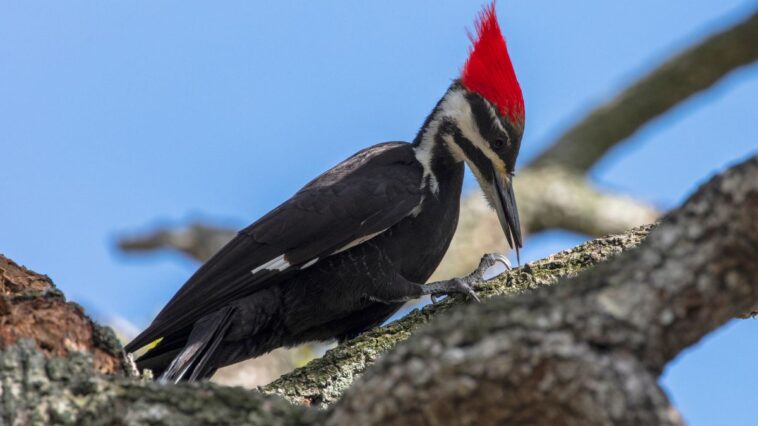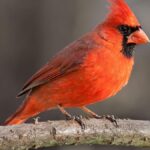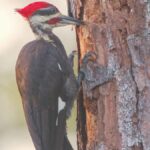Woodpeckers possess a unique anatomy that equips them for their specialized behaviors. Their chisel-shaped beak is strong and well-adapted for drilling into wood, while their shock-absorbing structures protect their brains from the impact of drumming and pecking. With powerful neck muscles, woodpeckers can strike their beaks against wood repeatedly. Their barbed and extensible tongue enables them to effectively reach deep crevices and extract prey.
Woodpeckers also have stiff tail feathers for stability, specialized feet, claws for climbing and clinging to tree trunks, and unique nostrils that protect them from inhaling wood particles. These anatomical features collectively allow woodpeckers to excel in drilling, drumming, and foraging.
Woodpeckers are a testament to how animals evolve and adapt to thrive in their habitats and lifestyles. They can excavate nesting cavities, find food sources hidden within the wood, and communicate through drumming. These adaptations make woodpeckers highly specialized for their ecological niche.
The Different Types of Woodpeckers
There are over 200 species of woodpeckers distributed worldwide. They vary in size, coloration, habitat preference, and behavior. Here are some examples of different types of woodpeckers:
- Downy Woodpecker (Picoides pubescens): The Downy Woodpecker is one of the smallest woodpecker species found in North America. It has a black-and-white pattern on its back, with a white belly and a small red patch on the back of its head. It inhabits various wooded habitats and is known for its drumming and tree trunk foraging.
- Hairy Woodpecker (Picoides villosus): Similar in appearance to the Downy Woodpecker, the Hairy Woodpecker is slightly larger. It has a similar black-and-white pattern but lacks a red patch on the head. It can be found across North America in forested areas and feeds on insects and tree sap.
- Pileated Woodpecker (Dryocopus pileatus): The Pileated Woodpecker is one of the largest woodpecker species in North America. Its striking appearance has a prominent red crest, black body, and white stripes on the face. It is known for its loud calls and powerful drumming. It inhabits mature forests and feeds on insects and fruits.
- Northern Flicker (Colaptes auratus): The Northern Flicker, also known as the Yellowhammer, is a medium-sized woodpecker in North America. It has a brown body, black bars on the back, and a distinctive black crescent on the chest. It often feeds on the ground, consuming ants and beetles, and is known for its distinctive “wick-a-wick-a-wick” call.
- Green Woodpecker (Picus viridis): The Green Woodpecker is a colorful species in Europe and Asia. It has a green body, yellow rump, and a red crown on males. It is known for its loud, laughing call and can often be seen foraging on the ground for ants.
- Great Spotted Woodpecker (Dendrocopos major): The Great Spotted Woodpecker is a widespread woodpecker species in Europe and Asia. It has a black-and-white body with a red patch on the belly and white spots on the wings. It inhabits various woodland habitats and feeds on insects, seeds, and fruits.
- Acorn Woodpecker (Melanerpes formicivorus): The Acorn Woodpecker is a unique species in North America, particularly in oak woodlands. It has a black body with a distinctive white face and a red cap. It is known for its communal breeding system, where several individuals help in raising the young, and its acorn storage behavior.
These are just a few examples of the diverse range of woodpecker species. Each species has its own ecological niche, distribution, and unique adaptations that allow them to thrive in their specific habitats.
Physical Characteristics and Adaptations
Woodpeckers possess several physical characteristics and adaptations that enable them to engage in unique behaviors and thrive in their environments. Here are some notable features:
- Beak: Woodpeckers have a strong, chisel-shaped beak that is longer than the average bird beak. This beak is specially designed for drilling into wood. It is composed of hard, dense bone with a sharp tip, allowing the woodpecker to excavate tree trunks and branches to find food, create nesting cavities, and communicate through drumming.
- Tongue: Woodpeckers have a long, flexible tongues extending far beyond their beak. The length and structure of their tongues enable them to reach their prey effectively. The tongue is covered in barbs or sticky saliva, which helps them capture insects and larvae hiding deep within tree crevices.
- Strong Feet and Claws: Woodpeckers have strong feet with sharp claws that allow them to cling to tree trunks and branches in various positions, including upside down. This adaptation allows them to move along the vertical surfaces of trees while searching for food or excavating nesting cavities.
- Stiff Tail Feathers: The tail feathers of woodpeckers are stiff and act as a supportive brace when perched against a tree trunk. This tail support allows them to maintain balance and leverage while drilling into the wood without losing stability.
- Skull and Brain Adaptations: Woodpeckers experience intense impacts while drumming and drilling into wood. They have evolved several adaptations to protect their brains from repetitive trauma. These include a spongy bone structure surrounding the skull that absorbs shock, cushioned brain tissue, and a specialized arrangement of bones, muscles, and tissues that help distribute and dissipate the forces.
- Camouflage and Coloration: Woodpeckers exhibit a range of color patterns, including black, white, gray, brown, and vibrant combinations. Their coloration often serves as camouflage, helping them blend with their surroundings. This camouflage is especially useful when they are foraging for insects on tree trunks.
- Specialized Ear Structure: Woodpeckers have a unique ear structure that protects their hearing during drumming. Their ears are covered with specialized feathers behind their eye sockets. This positioning helps dampen the noise and vibrations generated during drumming, preventing damage to their hearing.
These physical characteristics and adaptations collectively allow woodpeckers to effectively drill into wood, extract food, create nesting cavities, communicate through drumming, and navigate their arboreal habitats with agility and precision.
Habitat and Distribution
Woodpeckers are a diverse group of birds found in various habitats worldwide, except for extreme desert regions, polar areas, and some isolated oceanic islands. Their distribution spans from temperate to tropical regions, encompassing forests, woodlands, savannas, and urban areas. Here are some key points about their habitat and distribution:
- Forests and Woodlands: Many woodpecker species are closely associated with forests and woodlands. They are commonly found in deciduous and coniferous forests, where they can use abundant trees for nesting, foraging, and drumming. Different species may have preferences for particular types of trees or forest stages.
- Urban and Suburban Areas: Some woodpecker species have adapted to urban and suburban environments. These adaptable woodpeckers exploit trees in urban landscapes, including street trees, backyard trees, and wooden structures, for nesting and foraging. They can be found in cities’ parks, gardens, and wooded areas.
- Tropical Rainforests: Tropical rainforests are home to various woodpecker species. They can be found in the Amazon rainforest, African rainforests, Southeast Asian rainforests, and other tropical regions. These dense and diverse ecosystems provide abundant food sources and suitable nesting sites for many specialized woodpeckers.
- Boreal Forests: Woodpeckers are also present in boreal or taiga forests, characterized by extensive coniferous trees. These forests are located in the northern parts of North America, Europe, and Asia. Woodpecker species in boreal forests often rely on dead or decaying trees for nesting and foraging.
- Grasslands and Savannas: While woodpeckers are predominantly associated with forested habitats, some species inhabit open grasslands and savannas. These woodpeckers typically select habitats with scattered trees or woodlots to find suitable nesting cavities and forage on insects, fruits, or tree sap.
- Global Distribution: Woodpeckers have a worldwide distribution, with species on every continent except Antarctica. They exhibit diverse ranges and distributions across different regions. For example, North America has several species of woodpecker, including the iconic Pileated Woodpecker and the smaller Downy and Hairy Woodpeckers. Europe has species such as the Great Spotted Woodpecker, and Asia is home to the spectacular Flameback Woodpeckers.
It is important to note that specific woodpecker species may have more localized distributions within their respective habitats, depending on food availability, nesting requirements, and competition with other bird species.
Feeding Habits and Diet
Woodpeckers have a varied diet, primarily consisting of insects, larvae, and other invertebrates. However, their feeding habits and diet can also include plant materials such as fruits, nuts, tree sap, and occasionally small vertebrates. Here are some details about the feeding habits and diet of woodpeckers:
- Insects and Larvae: Woodpeckers are skilled insect hunters and have adapted to extract insects and their larvae from tree bark and wood. They use their strong beaks to peck, drill, and chip away at the bark, exposing hidden insects. They feed on many insects, including beetles, ants, termites, caterpillars, and spiders.
- Wood-boring Insects: Woodpeckers are particularly adept at finding and extracting wood-boring insects. These insects tunnel into the wood, and woodpeckers can detect their presence through vibrations and the sound they create. The woodpecker’s drilling and chiseling behavior often focuses on areas where wood-boring insects are present.
- Tree Sap: Some woodpecker species have specialized adaptations to feed on tree sap. They create small holes or wells in tree bark called “sap wells” and use their tongues to lap up the flowing sap. This behavior is commonly observed in sapsucker woodpeckers, such as the Yellow-bellied Sapsucker in North America.
- Fruits and Nuts: While insects form the bulk of their diet, certain woodpecker species also include fruits and nuts, especially when insect populations are low. They may feed on berries, apples, cherries, acorns, and other fruits readily available in their habitat.
- Caching Food: Some woodpecker species, such as the Acorn Woodpeckers, have unique caching behavior. They collect acorns or other nuts and store them in specially prepared holes or crevices in trees or wooden structures. These food caches serve as reserves during lean times or when resources become scarce.
- Foraging Techniques: Woodpeckers use different foraging techniques to locate and capture their prey. They use their strong beaks to probe and excavate holes in tree bark, often systematically moving vertically or horizontally along the trunk. They listen for sounds or vibrations indicating the presence of insects beneath the bark and then extract them using their long, sticky tongues.
Woodpeckers play a crucial role in maintaining the balance of insect populations in their ecosystems and contribute to the health of trees by removing infested wood. It is important to note that specific woodpecker species may vary their diet preferences and foraging techniques depending on their habitat and ecological niche. Additionally, diet variations may occur between seasons as food availability fluctuates.
Reproduction and Social Behavior.
Woodpeckers exhibit various reproductive behaviors and social interactions. Here is an overview of their reproduction and social behavior:
- Breeding Season: Woodpeckers generally have a specific breeding season, varying depending on the species and their geographic location. Some species may have a single breeding season per year, while others may breed multiple times in a season. Breeding seasons often coincide with the availability of food resources and favorable weather conditions.
- Courtship Displays: Male woodpeckers engage in courtship displays to attract females. These displays can involve drumming on resonant surfaces, such as tree trunks or metal objects, to create distinct sounds that advertise their presence and territory. They may also perform aerial displays, flapping their wings and making calls to impress potential mates.
- Pair Bonding: Once a pair bond is formed, woodpeckers are often monogamous, staying together for the breeding season or longer. They engage in mutual preening, grooming each other’s feathers, reinforcing their pair bond, and promoting mate selection.
- Nesting Cavities: Woodpeckers are cavity nesters, meaning they excavate their nesting cavities in tree trunks or branches. The chosen nesting site is usually a dead or decaying tree, as these offer softer wood for excavation. Both male and female woodpeckers contribute to the excavation process, with the male typically doing most of the initial drilling work.
- Egg-laying and Incubation: The female woodpecker lays eggs inside after excavating a suitable nesting cavity. The female then incubates the eggs while the male feeds her during this period. The number of eggs can vary among species but typically ranges from 2 to 6. Incubation duration can vary but is generally around 10 to 14 days.
- Parental Care: Once the eggs hatch, both parents participate in raising the young. They take turns feeding the nestlings by regurgitating food, primarily insects and insect larvae. As the nestlings grow, the parents gradually introduce solid food, such as fruits or nuts, into their diet. Woodpecker parents also remove waste from the nest to maintain cleanliness.
- Fledging and Independence: After a few weeks, the nestlings develop feathers and reach the fledgling stage. At this point, they leave the nest but stay nearby, relying on their parents for continued feeding and protection. The parents continue to care for and teach the fledglings essential skills, such as foraging techniques and vocalizations until they become independent.
- Territorial Behavior: Woodpeckers are often territorial during the breeding season. Territories can range in size depending on the species and available resources, and neighboring territories may overlap to some extent. Males defend their territories by drumming, calling, and engaging in aggressive displays toward intruders.
Woodpeckers display fascinating reproductive behaviors, and social interactions contribute to their survival and population dynamics. It’s worth noting that social behavior and breeding strategies can vary among different woodpecker species. Some species are more solitary, while others may exhibit cooperative breeding, where non-breeding individuals assist in raising the young.




